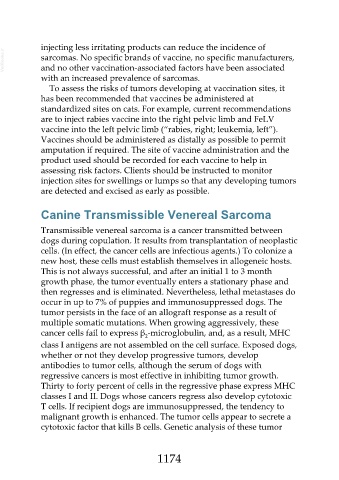Page 1174 - Veterinary Immunology, 10th Edition
P. 1174
injecting less irritating products can reduce the incidence of
VetBooks.ir sarcomas. No specific brands of vaccine, no specific manufacturers,
and no other vaccination-associated factors have been associated
with an increased prevalence of sarcomas.
To assess the risks of tumors developing at vaccination sites, it
has been recommended that vaccines be administered at
standardized sites on cats. For example, current recommendations
are to inject rabies vaccine into the right pelvic limb and FeLV
vaccine into the left pelvic limb (“rabies, right; leukemia, left”).
Vaccines should be administered as distally as possible to permit
amputation if required. The site of vaccine administration and the
product used should be recorded for each vaccine to help in
assessing risk factors. Clients should be instructed to monitor
injection sites for swellings or lumps so that any developing tumors
are detected and excised as early as possible.
Canine Transmissible Venereal Sarcoma
Transmissible venereal sarcoma is a cancer transmitted between
dogs during copulation. It results from transplantation of neoplastic
cells. (In effect, the cancer cells are infectious agents.) To colonize a
new host, these cells must establish themselves in allogeneic hosts.
This is not always successful, and after an initial 1 to 3 month
growth phase, the tumor eventually enters a stationary phase and
then regresses and is eliminated. Nevertheless, lethal metastases do
occur in up to 7% of puppies and immunosuppressed dogs. The
tumor persists in the face of an allograft response as a result of
multiple somatic mutations. When growing aggressively, these
cancer cells fail to express β -microglobulin, and, as a result, MHC
2
class I antigens are not assembled on the cell surface. Exposed dogs,
whether or not they develop progressive tumors, develop
antibodies to tumor cells, although the serum of dogs with
regressive cancers is most effective in inhibiting tumor growth.
Thirty to forty percent of cells in the regressive phase express MHC
classes I and II. Dogs whose cancers regress also develop cytotoxic
T cells. If recipient dogs are immunosuppressed, the tendency to
malignant growth is enhanced. The tumor cells appear to secrete a
cytotoxic factor that kills B cells. Genetic analysis of these tumor
1174

